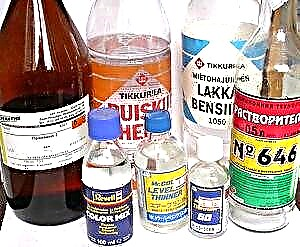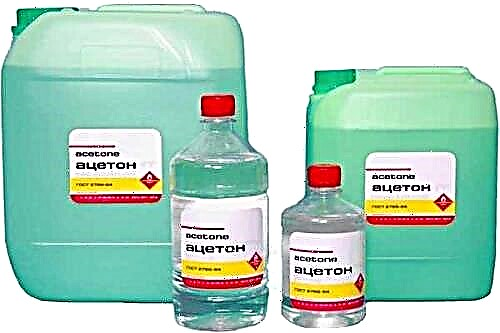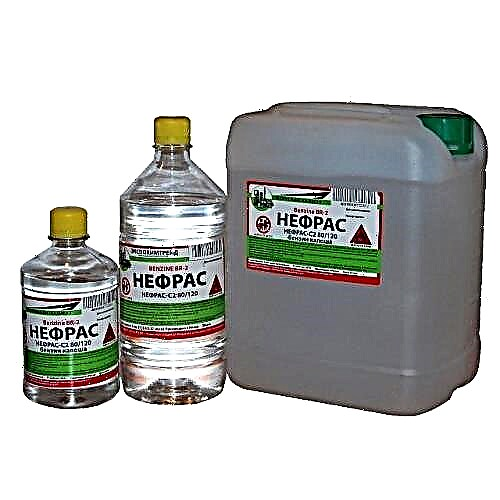Scopes of solvents and thinners are extensive. When performing repair work, we inevitably deal with solvents for varnish, enamel, paints. In construction, solvents of rust, concrete, water glass, liquid nails, polyurethane foam and other materials are used. Artists constantly use solvents, and in everyday life they help us remove complex pollution. Our article will help you understand this large topic so that you can quickly answer the question: which solvent is best used in each particular case.
Solvent and thinner: what is the difference?
The terms “solvent” and “diluent” are often used interchangeably. However, there is an important difference between them. In simple terms, the solvent interacts directly with the film-forming (curing) component.
For example, gasoline is a popular solvent for oil paints. It dissolves the binder, so it can dilute the paint for application and at the same time can remove stains of dried paint.
The diluent does not dissolve the substances forming the film, but can only reduce the viscosity of the composition. For example, water dilutes water-based paint well, but it will not be able to wash off dried paint.
Types of Solvents
For convenience, we divide all solvents into the following groups:
- Solvents for paints and varnishes (paints, enamels, varnishes), as well as adhesives and primers
- Solvents for building materials (solvents of bitumen, concrete, foam, rubber, rust, etc.)
- Household solvents (stains from oil, grease, adhesive tape, etc.)
- Art Solvents
Solvents for paints and varnishes
Almost all solvents for varnishes, paints and enamels are volatile organic substances with a low boiling point. These properties provide quick drying of the compositions after application.
There are solvents:
- homogeneous - based on a single substance or a mixture of homogeneous substances (e.g. toluene),
- combined - based on several homogeneous solvents in a certain proportion (for example, P-4 = toluene + acetone + butyl acetate).
As a rule, combined ones are characterized by higher efficiency and targeted action.
With the help of our table you can easily understand which solvents are used for which paints.
Purpose of solvents
Solvent
Type of paintwork
Homogeneous solvents
Solvent (more precisely thinner) of acrylic paint, water-based paint and other water-dispersible paints and nibble
Gasoline (gas galosh, nefras)
Thinner for oil and bitumen paints, varnishes, enamels
Solvent of oil and alkyd-styrene paints
Solvent of oil and alkyd paints and enamels (including PF-115, PF-133, PF-266), bitumen mastics, varnish GF-166, primer GF-021
Solvent of glyphthalic and bituminous varnishes and paints (including melamine alkyd).
Solvent of glyptal and bitumen varnishes and paints, epoxy.
Perchlorovinyl paint thinner
Combined (numbered) solvents
Universal solvent for nitro-paints, nitro enamels, general-purpose nitro-varnishes, also epoxy, acrylic, solvent
Thinner for nitroenamels, nitro coatings for cars
Thinner NTs-132k, GF-570Rk
Thinner of auto enamels NTs-11, GF-570Rk
Polyacrylate, perchlorovinyl, LKM with copolymers of vinyl chloride with vinylidene chloride or vinyl acetate
Perchlorovinyl, polyacrylate, epoxy
Melamine formaldehyde, rubber, polyvinyl butyral
VL-51 varnish thinning
Isocene Hardened Epoxy Enamels
Polyurethane varnish thinner
Polyester resin solvent
Solvent of polyurethane paints and enamels
Other useful properties of these solvents:
- cleaning and degreasing of the surface,
- Removing paintwork from brushes, rollers, spatulas and other tools.
Video about how to rinse the spray gun with a solvent
Paint removers: fresh and old
If during the work the paint stains were not where they needed (furniture, floor, glass were stained), it can be removed with solvents indicated in the table. True for delicate surfaces (wood, laminate, plexiglass), do not use combined compounds of the P-646 type. It is better to use homogeneous ones and be sure to first check their effect on an inconspicuous area.
Special solvents are available for removing old paints from large areas. They will help to remove paint from walls, from metal products, etc.
Solvents for building materials
Removing hardened mortars often causes serious difficulties. Manufacturers did everything possible to make bitumen, concrete, polyurethane foam, etc., as resistant to chemical influences as possible. What solvents will help in this case.
Solvent of concrete, cement, grout - a mixture of concentrated acid, protective substances for metals and inhibitors.
Liquid glass solvent - Instruments can be washed off with warm water immediately after application. Hardened can be removed with organic solvents.
Solvent for mounting foam - fresh foam is easily removed with ethyl acetate or solvents based on it (for example, P-645, 647). The solvent of the frozen construction foam can be considered the folk remedy "Dimexide" (sold in pharmacies). Also, Dimexide is an excellent solvent for superglue.
Liquid nail thinner - Unfrozen are removed with mineral-based solvents or water. Frozen can be removed mechanically or by heating with a hairdryer to a temperature above 50 ° C
Rust solvent - special formulations based on phosphoric acid, tannin, hydroxycarboxylic polybasic acids.
Silicone solvent (silicone sealant, glue) - Along with special compounds from sealant and glue manufacturers, you can use acetic acid or white spirit.
Polymer solvents:
— PVC - tetrahydrofuran, cyclohexanone for several days,
— polyethylene - xylene, benzene when heated,
— polyurethane foam - It is removed only with fresh special solvents from manufacturers.
Rubber and rubber solvent - toluene and other organic solvents are suitable for removing the substance (rubber dissolves, rubber swells and breaks down)
Bitumen mastic solvent - toluene, solvent, gasoline, white spirit
Foam Solvent - acetone, solvent R-650
Paraffin and Wax Solvent - kerosene, white spirit, gasoline, acetone.
In the next article, we will tell you about small household solvents and solvents used by artists.
How to choose paintwork for cars
There are several varieties of paints that are used for painting a car. Today, four of their types are most often used:
- acrylic enamels with the ability to dry quickly, forming a durable, shiny layer,
Each owner must decide for himself which material to choose for painting a car based on its properties or cost.
Solvents for car paint, their characteristics
The solvents used for the dilution of car paints are based on the same composition as other similar substances for any household work. Usually their constituent elements are:
According to the evaporation rate, diluents are divided into the following types:
- "Long", with poor volatility and slow evaporation rate, they are used in the summer,
- universal, used in the offseason, they have an average drying rate,
- "Fast", with very high volatility, used in the winter season.
In addition, there are polar or non-polar solvents. The first include substances that contain oxygen, which pulls together the electron cloud of other atoms in the molecule, making it polar. Substances of this type include:
- alcohols
- ketones
- water used to dilute aqueous emulsion materials.
Before you breed auto paint, you need to determine whether it belongs to the polar type or not. Non-polar substances have a hydrocarbon base, they are not suitable for diluting enamels, which include polar ingredients, namely oxygen or a hydroxyl group.
How to choose the right thinner for auto paint
In order not to make a mistake and correctly determine how to dilute car paint, you need to look at the composition of the elements included in auto enamel and solvent. It is desirable that among the constituent components they have the same elements. Here are some recommendations about which solvent to use when painting cars with various types of paints:
- acrylic enamels should be brought to the desired consistency with a special “Solvent for acrylic paints”, which can be replaced with similar mixtures of mixtures of grades 651 or P-12,
- Alkyd auto-paints are diluted with pure toluene or xylene, but solvent P-4 can also be used,
- nitro enamels, especially those with a metallic effect, are very sensitive to the choice of diluent, so it’s better to look at the manufacturer’s recommendations, which are usually indicated on containers with enamel (most often solvent 646 is suitable),
- Varnish coatings of the water emulsion type should be diluted with distilled water, ether or alcohol.
How to dilute acrylic enamel for a spray gun
The only valid formula that you should always adhere to when deciding how to dilute the paint, including acrylic, is to use the product recommended by the manufacturer and, preferably, the same brand as the enamel itself.
Before you dilute acrylic based enamel, it is necessary to add the recommended amount of hardener to it, and only then proceed to bring the paint for the spray gun to a more acceptable viscosity. Ideally, if you have a special device for measuring viscosity, called a viscometer.
A viscosity of 19–20 seconds is considered normal for acrylic paint. But how to dilute the paint for painting a car, if there is no such device? To do this, you must:
- Dilute acrylic paint with a specialized solvent (or No. 651 and R-12),
- Refill the spray gun and check its operation on the test surface. The paint mixture should easily pass through the nozzle, spraying evenly,
- If enamel is not sprayed or sprayed in large drops, add 5% solvent.
Usually water-based coatings, which include acrylic paint, can be diluted to 10-15% of their volume.
What determines the cultivation of enamels
The need to dilute enamel is dictated by its following properties:
The latter indicator is most important. At the same viscosity, coatings have different polymer concentrations. Greater filling is considered the best for a spray gun. This indicator is indicated on banks with the following markings, according to the degree of increase in fullness:
You can safely dilute highly filled VHS enamels, and very carefully, so as not to overdo it with a thinner - low-filled LS, bringing them to the desired consistency.
Painting with a transition is used for partial painting of a car, when it is not possible to choose the right tonality of paintwork materials to the color of the rest of the body surface. However, there are several methods for using a solvent for the transition, which can:
- applied to the border of two shades before applying the basic paintwork (it will lie on top of the solvent until it has completely evaporated),
- added to the base paint or varnish in a varying proportion (the first layer is ¾: 1, and the second - 1: 1),
- Spray along the transition contour after painting.
For such work, a special solvent is used for the transitions of the base paint or varnish. The second can be used for acrylic paints.
Description of solvents
Some people think that solvent and thinner are the same thing.. This opinion is erroneous.. The former are used to bring the paint to the desired state, and the latter are substances with the addition of a retarder, which slows down drying, prevents lumps, reduces tension and increases fluidity. In other words, adding a diluent to the paint does not involve chemical reactions.
The solvent is able to interact with the substance, penetrate its structure and dissolve the components of enamels, varnishes, etc.
Volatile solvent should evaporate gradually, otherwise defects may appear on the film surface. The main task of the solvent is to participate in the painting phase to give the paint materials the desired degree of viscosity. In addition, they also help clean clothes, tools and skin contaminated after painting.
The composition of organic solvents paints
Organic-based liquid substances are widely used due to their properties. Their use in the manufacture of paint products allows the use of materials at low temperatures, in humid environments, etc.
Few people at once will be able to determine whether a particular solvent belongs to a particular group. For some, the name of the chemical compounds is “dark forest”. However, not everything is as complicated as it seems at first glance. To understand their popular types will help the following information.
- To the group of hydrocarbons and their derivatives includes: refined gasoline, including Nefras and Galosha, turpentine, solvent, xylene.

- Ketones represented by acetone, methyl ethyl ketone, disobutyl ketone, cyclohexanone.
- To simple and complex esters includes dioxane, ethyl acetate, methyl acetate.
- Alcohols represents: ethanol, methanol, butanol, isopropanol.
Coloring compositions and their solvents
Paint is the most common building material used for indoor and outdoor use, as well as painting various surfaces. The composition of the solvent-based paint contains from 8 to 16 components, of which it can be noted:
- substance forming a film on the surface,
- hue pigment
- strength and gloss filler,
- desiccants that shorten the drying time,
- additives that enhance properties (fire safety, resistance to humid environments, etc.).
- Paint and varnish products are classified into three main groups:
- water emulsion (water-dispersed),
- alkyd oil
- enamels,
- epoxy.
1. What is a solvent and what is it for?
Solvent - it is a rapidly evaporating inorganic or organic substance. Depending on the composition may be:
Depending on the type of substance included in the composition, one-component solvents are divided into:
- organic (turpentine, kerosene, white spirit, solvent, gasoline),
- inorganic (water, liquid ammonia, phosphoric and sulfuric salts).
Organic solvents, despite the smell, are more in demand, and according to the rate of evaporation, they are divided into the following types:
- hardly volatile used to dilute car enamels and oil paints. This group includes, known to all, turpentine,
- medium volatile Suitable for acrylic or oil formulations. Kerosene belongs to this type, which undergoes special cleaning and only after that acquires the necessary properties,
- volatile used for car enamels, acrylic paints and varnishes and oil compositions. This includes white spirit, gasoline and solvent.
On a hot day, when direct sunlight is inevitable, the temperature is already high, it is better to use the third type, in the cool season - the first.
Besides dilution coloring formulations and their restoration upon drying, before direct application to surface, it must be degreased. This will help increase adhesion, especially if the surface is very smooth, such as metal. In addition, the paint will be more easily distributed on the surface, and the dried layer will be smooth and uniform. In the case of applying paintwork not with an ordinary brush or roller, but with special spray guns, there may be a need reduce density and viscosity of the composition. An accidentally dropped drop that was not noticed in time and managed to dry out will be easily wiped off with a suitable product. For a successful result, you only need to select correctly solvent appropriate type of used paints.
2. The principle of action
To understand this process, it is necessary to know which component is the main one or another coloring composition. Therefore, the solvent is selected similar in composition. When you add it to dried paint, it will complement her composition and make up for the evaporated part of the base. Thus, you will be able to achieve almost its initial state. The main thing, to stir thoroughly components among themselves, reaching the very bottom so that the solvent does not float on the surface and the composition becomes uniform in density. Basically, all interior paints are sold ready-to-use and do not need additional dilution. Only in the cases described above. There are a few simple rules adhering to which, you will achieve the best result:
- Tableware, in which you will do the work, it must be clean. No dried paint fragments from previous uses and no small debris. Rinse with water and wipe dry.
- The most suitable is packaging that has cylindrical shape with smooth walls. In such a vessel, you can move the components as evenly as possible.
- If we are talking about paints that are to be diluted water then its part should be no more than 10% of the total mass.
- In alkyd enamels, which will be used on outdoor works, it is necessary to add no more 3% of the total amount of fluid.
- For internal work - no more 5%.
If you add too much solvent, your paint will not stick and just drains from the treated surface. This is especially true for vertical planes on which streaks instantly form. Together with that declining and indicator operational qualities and coating service life. Let us consider in more detail the most common types of interior paints and the types of solvents suitable for them.
3. Solvent for alkyd paints
it oil formulations based on drying oils and enamel based on varnish. Resins are added as blowing agents. Depending on their type distinguish pentaphthalic (marking - PF) or glyphthalic (GF) enamel. In addition to liquid paints based on drying oil, they also produce thick-grated compositions (GF-013, PF-014, etc.). They are used both for external and internal works when finishing plastered, wooden or metal surfaces. They are fire hazard but it is absolutely non-toxic and lightfast.
- The most common and affordable means for diluting this type of paint is White Spirit. It is obtained in the process of distillation of petroleum products. Despite this, it is considered one of the most harmless and has the least pungent odor. It is also used for eliminate oil spots from the surface before coating and removing a viscous defect. With it, you can wash the brushes after work, speed up the drying process of oil compounds, protect the wooden surface from moisture and bark beetles.
- Turpentine obtained in the distillation process of coniferous resin. Most often used as thinner and fattener surface. You will not confuse this solvent with any other because of its sharp and unpleasant smell. Paint diluted with turpentine will dry out much longer, which is sometimes necessary. In case of skin contact in small amounts, it does not cause burns or irritation if has a high degree of evaporation. However, a surface treated with such a composition will be flammable.
- Solvent obtained by pyrolysis of petroleum feed or by coking of coal. It is a composition of light hydrocarbons. It has a very pungent smell and is toxic and flammable. Therefore, when working with it, it is necessary to ensure access of air to the room. And keep containers with it in a ventilated place without direct sunlight. When added to the paint, it is able to dry in a very short period of time, thanks to its high degree of evaporation. It copes with the elimination of oil and wax stains.
- Xylene (P-646) is organic chemical compound, obtained in the process of oil distillation. It is a liquid with low odor and very high evaporation rate. Used as thinner to obtain formulations of the required viscosity or for removal Alkyd paints from the surface. In the first case, it is added in small portions and thoroughly knead. In contact with skin or mucous membranes causes irritation. Therefore, work with it must be carried out in protective clothing and mittens, and upon contact, quickly rinse with soapy water under a stream of warm water.
Alkyd paints in a house are most often used for painting ceilings, walls in damp rooms, doors, window frames, heating radiators or various furniture items due to the fact that they form a more dense and durable coating. When choosing a solvent, carefully read the instructions on the labels, because not all of them are suitable for working with wooden surfaces.
4. Solvent for silicate compositions
Silicate paints are classified as mineral as the basis for them is liquid glass. They are fireproof, breathable and react poorly to moisture. They can be used for finishing plastered, stone or concrete surfaces outdoors and indoors. To dissolve this type of coating, you do not need to resort to the use of aggressive substances with pungent odors. Just apply silicate primer which can be found in any hardware store.
5. Solvent for emulsion and adhesive paints
Emulsion paints share for water emulsion, latex, acrylic, polyvinyl acetate and water dispersion. They can be applied to concrete, metal, wood or plastered surfaces. Are non toxic and fireproof. Adhesive compositions are made on the basis of aqueous solutions of organic polymers, for example, cellulose ether, polyvinyl alcohol, starch and casein. Their properties are very similar to emulsion, but are less resistant to moisture. Because of this, they are used for painting inside dry rooms. These types of coatings are practically no smell and due to its simple composition they can dissolve plain water in small quantities.
Withered acrylic paint tools can be removed by simply soaking in a soapy solution. For acrylic paints, solvents such asIT spirit, kerosene, solvent and gasoline.
6. Characteristics of some solvents according to their number
Due to the appearance of a large number of diverse types of multicomponent solvents, the most common and often used of them, assigned numbers. This greatly simplifies the selection.
- R-4 Is a mixture on basisacetone and toluene, which is very volatile. It is mainly used for dissolving alkyd paints, varnishes and enamels based on chlorinated polymers. Its application positive way affects on the consistency of the coloring matter and its ability to film. As a last resort, they can degrease surface, but will have to work very quickly because of its high degree of evaporation. When working with this substance, it is necessary to comply with fire safety rules and use personal protective equipment, since it is flammable.
- Solvent 646 – universal composition that is used both in everyday life and in industry. Its multifunctionality is explained by a multicomponent, complex composition. They can paint dissolve, and surface degrease and wipe off the old coating. It is yellowish and very pungent odor which disappears immediately after drying. When applied to the surface is very evaporates quickly and paint diluted with it dries too quickly. Sometimes this brings inconvenience, and it is replaced with weaker solutions. But the dried surface becomes smooth and shiny. They can breed Not only paint but also some types of putty. Him affordable price and the presence in any store made solvent 646 the most famous and sought after.
- RS-2 - clear liquid pale yellow based xylene and white spirit which also has good properties. It is used for dissolving oil varnishes, bituminous paints and pentaphthalic enamels. It evaporates very quickly, but is very dangerous. Extremely poisonous him couples have a strong effect on the central nervous system, internal organs, respiratory organs, skin, blood and even bone marrow. And with prolonged contact with unprotected skin, a rash provokes. Also, with the accumulation of its vapor in the air, it can an explosion occurs. Therefore, when working with the PC-2, you need to be very careful, use glasses, mittens, a respirator and ventilate the room well.
- RFG - this mixture ethyl or isopropyl alcohol with butyl or isobutyl in a ratio of 3: 1. It is used for diluting primers,
- P-647 suitable for diluting nitrocellulose enamels and primers,
- R-649 and R-650 - for diluting glyptal and nitrocellulose enamels, soils,
- RCCH - solvent for paints on a rubber basis. So toxic that you need to work with him in a protective suit,
- RS (1-2) suitable for oil paint,
- RE (1-4) - compositions for working with enamels.
Be careful, all solvents, the number of which begins with the letter "P", are industrial, which means that they are extremely dangerous to health.
Most popular remedies
There are a lot of solvents. The most commonly used are:
 acetone,
acetone,- xylene
- solvent
- petrol,
- turpentine,
- White Spirit,
- solvents (P-4, 646, 647, 649, 650).
Acetone
Using acetone, you can create the desired consistency of perchlorovinyl paints for easy application to the surface. It is used for degreasing rubber, dissolving salts and removing wax. It dissolves organic and epoxy resins, oils during the synthesis of polyurethanes and polycarbonates.
Xylene
Suitable for dissolving epoxies, bituminous varnishes and glyphthalic based paints. It is used in the process of dye synthesis. With xylene, the paint becomes brighter, but dries longer.
Solvent
This substance can dissolve melamine-alkyd varnishes. Using solvent increases the fluidity of the dyes from bitumen or glyptal.
Petrol
 It is actively used in the rubber industry as a solvent. It is used to clean grease surfaces for bonding. Gasoline is used to dissolve enamels and oil paint products.
It is actively used in the rubber industry as a solvent. It is used to clean grease surfaces for bonding. Gasoline is used to dissolve enamels and oil paint products.
Turpentine
Used to dissolve oil and alkyd-styrene paints. Turpentine is suitable for removing dried paint on its own or in combination with other solvents. The substance is low toxic, has a coniferous smell.
White Spirit
It is very popular due to the fact that it is practically not harmful to health (but, of course, you should not drink it), it is often used to clean hands stained with paint. It is often used in everyday life, as it is able to break down vegetable oils and fats, nitrogen organic compounds, and oil fractions. White spirit is also actively used in industry for the dissolution of oil paints, rubber and bituminous mastics, various varnishes and enamels.
A rather complex substance. Synthesize it using a compound of esters, hydrocarbons and ketones. It is used for dyes with polyacrylate and polyvinyl chloride, and paint and varnish materials are bred on vinylidene chloride and vinyl acetate.
646
Consists of a mixture of toluene, ethanol, butyl acetate, butanol, ethyl cellosolve and acetone. With its help, epoxy and acrylic varnishes are bred. The substance is not very toxic, therefore, when working with it do not use protective equipment. Sold in many hardware stores, used in everyday life to work with putty.
A mixture of toluene, butyl acetate, ethyl acetate and butanol. It is used in the process of painting cars, allowing you to breed nitrol varnish and nitro enamel.
Consists of xylene, ethyl cellosolve and butanol. It is used for diluting paints and enamels. More toxic, therefore, protective equipment is required to work with it. In addition, the substance itself must be protected from direct sunlight, as well as stored in a dark, tightly sealed container.
650
A mixture of xylene, butyl alcohol and ethyl cellosolve. With its help, paints and enamels are bred. The substance is toxic, therefore protective equipment is required.
Safety regulations
 It is important to know that the vapors of many solvents when combined with air constitute an explosive mixture, therefore it is important not to use substances near an open flame, not to smoke during work, etc.
It is important to know that the vapors of many solvents when combined with air constitute an explosive mixture, therefore it is important not to use substances near an open flame, not to smoke during work, etc.
Most have a strong specific smell. The room in which work takes place should be aired to avoid poisoning.
Protect exposed skin from skin contact.. Despite the fact that some solvents are practically safe, it is still not worth contacting them again to avoid health problems. Solvents are active chemicals and should be handled with care. By following the simplest rules, you can protect yourself from unnecessary problems.
Water-dispersed materials and their solvents
Acrylic paints widely used for interior work. They have high decorative qualities, resistance to ultraviolet rays. Of the advantages, fire safety and non-toxicity are noted.
- Despite the fact that water is used as a diluent, after drying, a strong layer forms on the painted surface. Fresh drops are easily cleaned with a wet cloth. If the coloring matter on the instrument has managed to dry, then it can be soaked with a warm soapy solution.
- As a solvent for acrylic paint used gasoline, acetone, white spirit, kerosene. His choice depends on the surface being cleaned. In construction stores, a special tool is widely presented, which is called “Acrylic Paint Remover”.

Latex paint It is used for coating surfaces of various materials (concrete, galvanized, wooden, plastic, etc.). Such a tool forms a durable, water-repellent and dense layer.
- To obtain the necessary viscosity, it is diluted with water.At the end of the painting work, the instrument and drops on objects are immediately washed with water. Dried contaminants can be cleaned with toluene, methylbenzene.
- These alcohol components are part of organic solvents: R-4, R 646, 647, 648. Such funds should be used with caution when trying to wash off drops of paint from the floor. Here you can use a more gentle method - soaking the stains with water diluted with kerosene.
Polyvinyl acetate paint it is applied on plastered, wooden or plasterboard surfaces. Dispersion based on PVA is not resistant to wet conditions, so it is more suitable for indoor work in dry rooms.
- The coloring matter is easily washed off with a sponge dipped in soapy water. Small drops in small quantities are simply removed mechanically, for example, with a knife or spatula.
- The hardened polymer film can be moistened with water and directed warm air with a hairdryer. The softened layer leaves without much effort. Old contaminants are cleaned with acetic acid, white spirit, acetone, benzene, methanol.

Silicone paint forms a reliable, waterproof layer. An elastic coating combines all the best properties of water-dispersed materials. Its advantage lies in the so-called lotus effect - water droplets roll off the surface, entrapping foreign particles.
- Fresh stains are removed with a dry and damp cloth without difficulty. For dried drops, mechanical means are used. Long-standing contaminants are cleaned with hydrocarbon-based organic solvents or ether and ester substances. Such chemical fluids should be used with care on plastic surfaces.
Oil-alkyd materials and their solvents
Oil paint - the most affordable type among similar products. If initially the composition was based on natural drying oil, today oxidized and artificial drying oils are used to reduce the cost. Despite the fact that the material is characterized by a very persistent toxic odor and a long drying time, it does not lose its popularity.
- Fresh drops are wiped off with a rag soaked in a solvent for oil paint. White spirit, turpentine, kerosene, refined gasoline (Nefras), butanol or ammonia are excellent for these purposes.

- Since the paint forms a fairly durable coating, old dirt can be removed with great difficulty. As solvents of old paints, special numbering compounds P 647, 651 can be used. Remember when working with highly toxic chemical compounds do not neglect personal protective equipment.
Alkyd paint penetrates the surface structure, due to which a durable, moisture-resistant layer is obtained. The composition is resistant to mechanical damage and adverse climatic conditions. The drying oil laid in the foundation determines the following indices: GF, PF, KO.
- Drops of HF enamels are easily removed with turpentine or white spirit, PF with xylene, solvent or gasoline, as well as with their mixture 1: 1, KO - P-4, P-6, solvent No. 646, No. 649, No. 650.
- For old dirt, you can use special tools - washes. When working with them, care should be taken, since their effect may not be limited to the paint itself. The active substance is able to dissolve the previous layers of primer, putty.
Nitro enamels and their solvents
Nitro enamel used for painting various surfaces, where metal structures occupy a special niche. Paint with a rather pungent odor dries in 1-2 hours. Glossy coating will last a considerable period.
- The best solvents for paint NTs are considered to be combined compositions under No. 645, 646, 647, 649, 650. They are used as thinners for thickened enamel, degreasing surfaces, and removing paint residues from building tools.
- It is possible to clear pollution with rags moistened in acetone, ethyl acetate, butyl acetate and other similar products of group of simple and esters.

Epoxy materials and their solvents
Epoxy paint It differs in a number of advantages, among which they note: high resistance to abrasion, a long service life and a presentable appearance. However, super-strength and resistance to many chemicals has the opposite side - slightly dried material is practically impossible to remove.
- Wipe off a fresh stain immediately with a dry and clean cloth. If contamination was not noticed on time, then it is worth using a mechanical method. With relatively large drops, you can use the numbering composition P-5, P-14, P-40, P-83.
Compatibility of varnishes, paints, solvents
- Proper selection of the solvent, depending on the composition of the paintwork, will avoid coagulation, the formation of blisters or cracks after applying the dye. When removing contaminants formed by these materials, appropriate solvents should be selected.
- By adhering to such principles, it will be possible to achieve maximum results. Before work, grout in an inconspicuous area. Chemically active compounds will perfectly cope not only with spots of paint, but also with subsequent finishing layers of the base.
- In the cleaning process, one should rely not so much on the amount of solvent used as on the mechanical effect. That is, rubbing a few drops of a liquid substance is quite enough to remove even strong impurities.

 acetone,
acetone,

